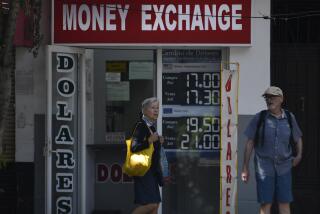In Brazil, It’s Nail Biting Time : Index Slides 9% on Currency Fears
- Share via
MEXICO CITY — Just as memories of the “Tequila effect” of the late-1994 peso crisis began to fade thanks to Mexico’s broad recovery, Brazil suddenly appears vulnerable--raising fears of a “samba effect” that could dampen growth throughout Latin America.
Brazil’s main Bovespa stock market index tumbled 9.8% on Thursday in the face of concerns that the nation’s currency has become the latest target of speculators after their relentless raids against Southeast Asian and Hong Kong currencies in recent months.
Brazil’s Central Bank felt compelled to issue a statement denying that the nation’s banks had liquidity problems as a result of stock market losses totaling more than 20% over the last week.
But the Central Bank confirmed it spent nearly $5 billion in foreign reserves this week to defend the Brazilian currency, the real. The real slipped Thursday from 1.104 to 1.106 against the U.S. dollar.
Later in the day, after downplaying the threat to the currency, the Central Bank moved more aggressively to defend the currency, doubling its basic interest rate to 3.05% a month. That was to encourage holders of reals to keep them, and discourage speculators from betting against the real.
“This is very classic but very aggressive,” said the chief economist in Brazil for Banco Santander. “It signals they are ready to defend the real no matter what the cost.”
The new rates were “emergency measures for a period of crisis,” a Central Bank spokeswoman said.
The worries over Brazil sent shudders through markets throughout the region. In Argentina--heavily dependent on Brazil as an export market--stocks fell 9.1%. In Mexico, the main share index fell 3.4%. Mexican analysts cited fears that Brazil’s problems could shake investor confidence and lead to a regional economic slowdown.
Brazil has built its impressive 3-year-old economic recovery program, called the Real Plan, on a policy of high interest rates and tight exchange rate management to control inflation, which historically has plagued South American countries. The restructuring program has produced unprecedented stability and a flood of foreign investment into Brazil, expected to top $15 billion this year. Inflation has tumbled from 2,000% to single digits.
But economists have questioned whether the real is overvalued, prompting higher imports and feeding a worrisome current account deficit.
That scenario is similar to Mexico in 1994 in the months leading up to the peso crisis. As its foreign reserves dried up and its currency was repeatedly challenged, Mexico ultimately was forced to devalue its currency dramatically, leading to a severe recession, 50% inflation, high unemployment and soaring interest rates. That in turn hurt investor confidence throughout Latin America and other emerging nations, in what became known as the tequila effect.
Brazilian Central Bank President Gustavo Franco has remained steadfast in seeking to protect the value of the real, however, to the extent of spending nearly 10% of Brazil’s $60 billion in foreign exchange reserves this week to maintain the currency’s strength.
Franco told reporters in Brasilia on Thursday, “All is tranquil.”
But the central bank also doubled its basic interest rate, to 3.05% a month from 1.58%, to defend the currency.
Jose Ramon Tora, who monitors Latin American financial institutions for Standard & Poor’s, said many Brazilian banks depend heavily on investments rather than strong deposit bases, so swings in the market can affect the banks’ liquidity significantly.
“You also have to keep in mind that banking systems depend substantially on confidence. In a very general sense, if there is a loss of confidence then there is pressure on the currency and interest rates,” he said.
While Brazil was coming under attack and some voiced fears of a regionwide weakening, Mexican President Ernesto Zedillo took the occasion to boast about his country’s relative stability. He told a gathering of investors Thursday that the Mexican stock and currency markets’ resilience in response to the foreign market gyrations this week was a vindication of his government’s tough recovery program.
Zedillo said a key factor in Mexico’s performance was the increased transparency of its economic policy, built on open and thorough disclosure of policies and accurate, timely information for the markets. A lack of such openness has been blamed for investors’ flight from Thailand, Malaysia, Indonesia and China in recent weeks.
Unlike Brazil and neighboring Argentina, which has fixed its peso at 1 to 1 with the U.S. dollar, Mexico has adopted a floating exchange rate, and lets market forces determine rates rather than use its foreign reserves to adjust them. The Mexican peso fell 1.2% on Thursday, which analysts attributed primarily to concern over Brazil’s situation.
The floating rate is a cornerstone of the Mexican recovery program instituted in 1995 following the peso devaluation of December 1994.
Former U.S. Treasury Secretary Lloyd Bentsen, in Mexico City for the Zedillo gathering, agreed that the recent Asian currency problems arose in part because those countries had failed to provide sufficiently timely and transparent information. He said Mexico was setting an example in its approach to investors.
Bentsen added: “I personally made an investment in Mexican stocks on Tuesday morning,” the point where the market was lowest after its 13% fall on Monday and just ahead of its 11% rebound. “And I wish I had invested more.”
(BEGIN TEXT OF INFOBOX / INFOGRAPHIC)
Sudden Reversal
After rocketing in the first half of this year on rising hopes for the Brazilian economy, the Bovespa stock index has plummeted in recent weeks, losing 9.8% on Thursday alone. Monthly closes and latest:
Thursday: 8,855
Source: Bloomberg News
More to Read
Sign up for Essential California
The most important California stories and recommendations in your inbox every morning.
You may occasionally receive promotional content from the Los Angeles Times.









